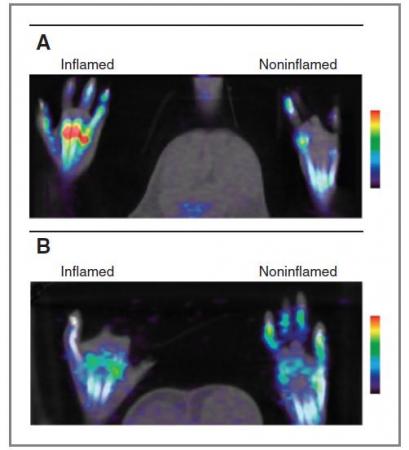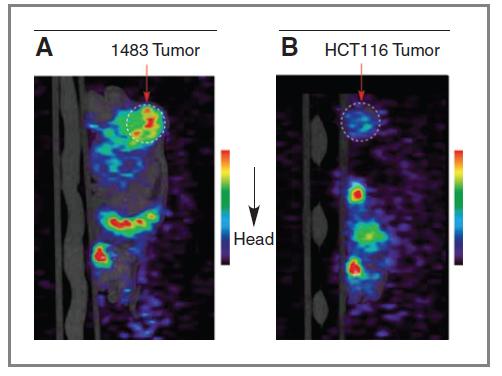
炎症反应成像图片

肿瘤成像图片
美国科学家研发新的成像试剂可以“观察”到早期的肿瘤。
该化合物源为COX-2酶抑制剂,它可以通过正电子放射X线断层摄影术成像(PET)检测到,在癌症的发现、诊断及治疗中有着广泛的应用前景。
美国范德比尔特大学的科学家们将这项最新的发现发表在了《Cancer Prevention Research》杂志上。
该论文的通讯作者,该大学生物化学学院的Lawrence Marnett博士说道:“这种成像技术已经证实在动物实验中能成功的检测炎症反应和癌症。”
COX-2在分子成像上有着潜在的应用能力,它在大部分的正常组织中都不表达,而在发生炎症的组织和肿瘤中能检测到表达。
Marnett说道:“当肿瘤逐渐成长和恶化时,COX-2的表达水平也会随之上升。”
未来开放出靶向COX-2的成像试剂,该学院的助理研究员Jashim Uddin博士使用了抗炎药ndomethacin和celecoxib化学分子中的核心结构,并通过化学反应加入氟元素来改造它们。
在证明了这种氟化物是COX-2的抑制剂后,科学家们将其改成了具有放射性的氟元素(18-F),通过静脉注射这种18-F化合物到动物体内,他们才拥有足够的信号来进行PET成像。
科学家们在实验中使用了两种动物模型来证实该方法的有效性:在足部进行刺激诱导炎症的大鼠和移植有人类肿瘤的小鼠。
结果显示18-F化合物富集于发生炎症反应的大鼠足部,而未发生炎症反应的大鼠足部检测不到,且与处理celecoxib会阻断该信号的检测。在COX-2表达阳性和COX-2表达阴性的人类肿瘤中,18-F化合物仅富集于COX-2阳性的肿瘤中。
这项研究可在未来用于早期检测癌症的探针,并通过COX-2的表达情况来评估肿瘤的恶化程度。
“因为COX-2表达水平在所有实体肿瘤恶化过程中均会上升表达,我们认为这项成像技术有着非常广阔的临床应用前景。” Marnett说道。(生物探索 Jun)
相关英文论文原文:
Fluorinated COX-2 Inhibitors as Agents in PET Imaging of Inflammation and Cancer
COX-2 is a major contributor to the inflammatory response and cancer progression so it is an important target for prevention and therapy. COX-2 is absent or expressed at low levels in most epithelial cells but is found at high levels in inflammatory lesions, and many premalignant and malignant tumors. Thus, it is an attractive target for molecular imaging. We report a series of novel fluorinated imaging agents, derived from indomethacin or celecoxib that selectively inhibit COX-2. The most promising lead, compound 7, was a fluorinated derivative of celecoxib. Kinetic analysis revealed that this fluorinated compound is a slow, tight-binding inhibitor of COX-2 and exhibits minimal inhibitory activity against COX-1. Efficient incorporation of 18F into compound 7 by radiochemical synthesis and intravenous injection provided sufficient signal for in vivo positron emission tomography (PET) imaging. Selective uptake of 18F-7 was observed in inflamed rat paws compared with the noninflamed contralateral paws and uptake was blocked by pretreatment with the COX-2 inhibitor, celecoxib. Uptake of 18F-7 was not observed when inflammation was induced in COX-2–null mice. In nude mice bearing both a COX-2–expressing human tumor xenograft (1483) and a COX-2–negative xenograft (HCT116), 18F-7 selectively accumulated in the COX-2–expressing tumor. Accumulation was blocked by pretreatment of the animals with celecoxib. The in vitro and in vivo properties of compound 7 suggest it will be a useful probe for early detection of cancer and for evaluation of the COX-2 status of premalignant and malignant tumors.
英文论文链接:https://www.biodiscover.com/news/biotechnology/library/1345.html







